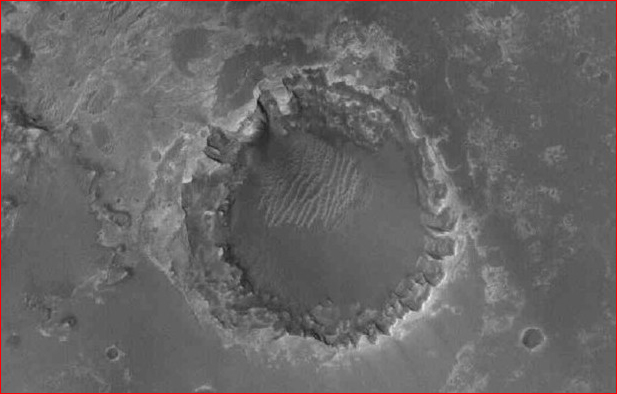
home •
about •
essential guide •
picture of the day •
thunderblogs •
news •
multimedia •
predictions •
products •
get involved •
contact

Credit: NASA/JPL/Malin Space Science Systems
pic of the day
archive
subject index
abstract
archive
Links:
Society for
Interdisciplinary
Studies
Sep 19, 2005
Mars Bears Witness
This crater in Meridiani Planum has acted as a “witness plate” in a high-energy plasma discharge. (Witness plates—thin layers of some material—are placed in the path of laboratory discharges. A discharge strikes the plate and burns in a record of the discharge channel’s shape.) Laboratory experiments and computer simulations have shown that such discharges often filament into 56 separate channels around the edge of the overall channel. These filaments then usually combine in pairs to form 28 larger filaments. If the discharge persists, other forms evolve in the channel.
The shape of this crater suggests that the thunderbolt that formed it quenched shortly after evolving into the 28 filaments: The lower right quadrant, where the “bays” around the edge of the crater are most pronounced, contains 7 of them. If that fineness of detail had been preserved around the entire rim, there would be a total of 28 bays.
Art and artifacts made by prehistoric humans have also left a record of 56- and 28-fold forms. Pictographs and petroglyphs—images painted on or pecked into rock faces—attest to the occurrence of high-energy plasma discharges witnessed by early peoples. Prehistoric stone circles also replicate the pattern. And the pattern has been passed down in art and architecture.
The occurrence of this 28-fold form in human records and in the Martial surface bears witness to a recent period of high-energy plasma discharges within the Solar System.
EXECUTIVE EDITORS:
David Talbott, Wallace Thornhill
MANAGING EDITOR:
Mel Acheson
CONTRIBUTING EDITORS: Michael Armstrong, Dwardu Cardona, Ev Cochrane,
C.J. Ransom, Don Scott, Rens van der Sluijs, Ian Tresman
WEBMASTER: Michael Armstrong
Copyright 2005: thunderbolts.info